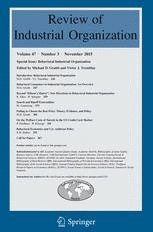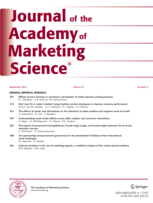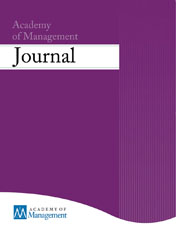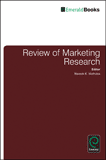Academic articles
Practitioner articles
Working papers
Books
Book chapters
Case studies
Other publications
Subject(s)
Economics, politics and business environment; Finance, accounting and corporate governance
Keyword(s)
Sophistication, naiveté, credit market, consumer exploitation
In the presence of naive consumers, a participation distortion arises in competitive markets because the additional profits from naive consumers lead competitive firms to lower transparent prices below cost. Using a simple calibration, we argue that the participation distortion in the US credit-card market may be large. Our results call for a redirection of some of the large amount of empirical research on the quantification of the welfare losses from market power, to the quantification of welfare losses that are due to the firms’ reactions to consumer misunderstandings.
© Springer Science+Business Media New York 2015. With permission of Springer
Volume
47
Journal Pages
341–354
Subject(s)
Economics, politics and business environment
Keyword(s)
Primary school enrollment, school lunches, natural experiment, ITT
At the end of 2001, the Indian Supreme Court issued a directive ordering states to institute school lunches – known locally as "midday meals" – in government primary schools. This paper provides a large-scale assessment of the enrollment effects of India's midday meal scheme, which offers warm lunches, free of cost, to 120 million primary school children across India and is the largest school feeding program in the world. To isolate the causal effect of the policy, we make use of staggered implementation across Indian states in government but not private schools. Using a panel data set of almost 500,000 schools observed annually from 2002 to 2004, we find that midday meals result in substantial increases in primary school enrollment, driven by early primary school responses to the program. Our results are robust to a wide range of specification tests.
© The editors of The Scandinavian Journal of Economics 2015
Volume
117
Journal Pages
1176–1203
ISSN (Online)
1467-9442
Subject(s)
Human resources management/organizational behavior
Keyword(s)
Sensemaking, spousal support, career decision making, family identity
This paper contributes to a growing body of literature on the role of family in managers’ career decision making. Specifically, we offer an empirical elaboration on a recently proposed concept of the “family-relatedness of work decisions” (FRWD) by illuminating the role of the spouse in managers’ career sensemaking. Eighty-eight managers who were in the final stage of their EMBA program took part in the study. The data were gathered through a personal career inventory. The findings revealed that next to family-career salience and parent role identification, spouses also play an important role in shaping managers’ family-related career sensemaking. Future research should examine the supportive role of spouses in contexts other than that of an international EMBA. Moreover, researchers should examine the role of managers’ boundary management styles in shaping the degree of their family-related career sensemaking. Our paper suggests that when designing and implementing developmental initiatives, organizations should consider that managers’ decisions about their next career steps may be guided by family-related concerns, and the spouse may play a specific role. This paper offers the first empirical exploration and a refinement of the nascent theory of the “family-relatedness of work decisions”. It also introduces a new construct into the theory – spousal career support – that opens new avenues for future research.
With permission of Emerald
Volume
20
Journal Pages
503–524
Subject(s)
Economics, politics and business environment
Keyword(s)
Strategic experimentation, Bayesian learning, cheap talk,
two-armed bandit, information externality
JEL Code(s)
C73, D83
We consider two players facing identical discrete-time bandit problems with a safe and a risky arm. In any period, the risky arm yields either a success or a failure, and the first success reveals the risky arm to dominate the safe one. When payoffs are public information, the ensuing free-rider problem is so severe that the equilibrium number of experiments is at most one plus the number of experiments that a single agent would perform. When payoffs are private information and players can communicate via cheap talk, the socially optimal symmetric experimentation profile can be supported as a perfect Bayesian equilibrium for sufficiently optimistic prior beliefs. These results generalize to more than two players whenever the success probability per period is not too high. In particular, this is the case when successes occur at the jump times of a Poisson process and the period length is sufficiently small.
With permission of Elsevier
Volume
159
Journal Pages
531–551
Subject(s)
Management sciences, decision sciences and quantitative methods
Keyword(s)
Shapley value, potential, random partition, concentration of power
JEL Code(s)
C71
We provide new formulae for the potential of the Shapley value that use the multilinear extension of coalitional games with transferable utility.
With permission of Elsevier
Volume
135
Journal Pages
28–30
Subject(s)
Marketing
Keyword(s)
Customer inoculation, customer satisfaction, services marketing, service failure
Capitalizing on a large-scale field experimental dataset involving 1,254 airline customers, this study introduces customer inoculation as a new, proactive strategy for mitigating the negative consequences that service failures have on customer satisfaction. Results confirm that customer inoculation eases the decrease in satisfaction when customers experience a service failure. Additional analyses indicate that customer inoculation does not harm customer satisfaction if no service failure occurs. This finding sets inoculation apart from expectation management and underscores the potential inoculation has for marketing practice. Furthermore, contrary to traditional recovery strategies for addressing service failures, customer inoculation operates in advance of a service failure and thereby circumvents potential drawbacks of traditional strategies. In sum, customer inoculation represents a novel strategy for addressing service failures with respect to existing marketing literature and expands the scope of action for companies when they cannot avoid offering occasionally flawed services.
© Academy of Marketing Science 2014 With permission of Springer
Volume
43
Journal Pages
512–527
Subject(s)
Technology, R&D management
Keyword(s)
Selection, evaluation, user-based innovation, crowd sourcing
When organizations reach out to their users for ideas, users take on a considerable role in the innovation process. Including users expands the number of participants and potential ideas from which an organization can select. But how do organizations select some user suggestions while rejecting or ignoring others? We analyze the selection processes at 24,067 organizations that collectively received 702,729 suggestions. Our findings suggest that organizations filter the suggestions they receive by focusing on suggestions that inspire feedback from the user community.
Despite receiving contributions from a diverse pool of users, organizations quickly settle into a pattern of attending to only a few. To our surprise, collective user preferences only matter as a filter mechanism when crowding is high. In contrast, the debate among users about a suggestion strongly increases the likelihood of it being selected by the organization. Our illustration of the screening criteria organizations use to winnow suggestions has broad implications for the selection literature. We also bring insight to the literature on user-driven innovation processes by studying all suggestions that were considered, rather than only those organizations select and implement.
With permission of the Academy of Management
As of May/June 2016, this highly cited paper received enough citations to place it in the top 1% of the academic field of Economics & Business based on a highly cited threshold for the field and publication year. – Data from Essential Science Indicators℠
As of May/June 2016, this highly cited paper received enough citations to place it in the top 1% of the academic field of Economics & Business based on a highly cited threshold for the field and publication year. – Data from Essential Science Indicators℠
Volume
58
Journal Pages
856–880
Subject(s)
Human resources management/organizational behavior
Keyword(s)
Status, US venture capital industry
This article introduces a distinction between two kinds of status and investigates their effects empirically on the life chances of U.S. venture capital organizations. Using recent research on status-based competition as our starting point, we first describe primary status as a network-related signal of an organization’s quality in a leadership role, and measure primary status as the degree to which a focal organization leads others that are themselves well regarded as lead-organizations in the context of investment syndicates. We then introduce complementary status as an affiliation-based indicator of an organization’s quality in a supporting role, measuring complementary status as the extent to which a focal organization is invited into syndicates by well-regarded lead-organizations—that is, by organizations possessing high levels of primary status. Findings show that both kinds of status negatively affect the rate at which venture capital organizations exit the industry. In addition, consistent with the proposition that primary status and complementary status correspond to distinct market roles and different market identities, primary status and complementary status attenuate each other’s favorable main effects on survival for dedicated venture capital organizations. Theoretically and methodologically oriented scope conditions as well as implications for future research are discussed.
With permission of Elsevier
Volume
52
Journal Pages
588–601
Subject(s)
Ethics and social responsibility; Marketing
Keyword(s)
Attachment, identification, social identity, consumer-brand relationships, brand loyalty
We examine two conceptualizations of consumer-brand relationships: identification, as identity-based relationships between a consumer and a brand, and the related construct of attachment as a bond based on security and personal history with the brand.Predictions emanating from the two constructs’ disparate theoretical traditions regarding the relative antecedents and outcomes of these brand relationship constructs are tested in a survey of real consumer-brand relationships, where the two are likely to co-occur. Identification is more socially motivated, wherein the brand is used for “identity building” and impression management, such as through public endorsement. In contrast, attachment is more personally motivated; it is more likely to be founded on an intimate history with the brand and feelings of security inspired by the brand. This is the first work in marketing to explicitly compare identification with attachment in contexts where they co-occur. In doing so, it underscores the validity and usefulness of these two related but distinct relationship constructs.
With permission of Emerald
Volume
12
Journal Pages
151–174
Subject(s)
Technology, R&D management
Keyword(s)
social networks
Volume
93
Journal Pages
1687–1722





